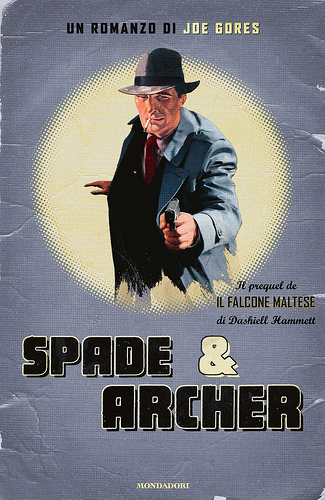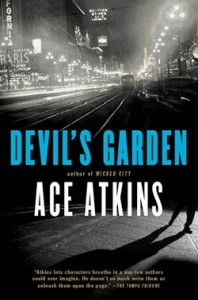Of Joe Gores, Ace Atkins and Wrestling with Hammett’s Legend
 The recent passing of veteran mystery writer Joe Gores on the anniversary of Dashiell Hammett’s own death set me thinking about Hammett’s enduring legacy and continuing influence on detective fiction.
The recent passing of veteran mystery writer Joe Gores on the anniversary of Dashiell Hammett’s own death set me thinking about Hammett’s enduring legacy and continuing influence on detective fiction.
Gores was born too late to fight for a place in the Holy Trinity of hardboiled detective fiction alongside Hammett’s immediate heirs Raymond Chandler and Ross Macdonald, but the influence of the man who did so much to transform hardboiled fiction was no less strong in Gores’ work.
While most commentators would agree that the DKA series was Gores’ crowning achievement, my own preference was for his 1975 novel, Hammett and his last book, 2009’s Spade & Archer.
Gores’ death led me to pick up Ace Atkins’ 2009 novel, Devil’s Garden. Atkins’ book is a semi-fictionalized account of Hammett’s real-life involvement as a Pinketeron operative gathering evidence for the scandalous Fatty Arbuckle trial in 1921.
When granted the honor of penning a prequel to The Maltese Falcon, Gores later drew heavily on Hammett’s own experiences as a Pinkerton to fill in Sam Spade’s back story. Atkins has much in common with Gores in that both men are natural writers who can easily make one envious of their prodigious talent and, at times, frustrated that they aren’t quite as perfect as you wish them to be.
No matter how many times I’ve read Hammett’s five novels and the posthumous collections of his short fiction, I never cease to be amazed at his perfection. Chandler’s remark that Hammett repeatedly wrote scenes that struck readers as wholly original is not mere hyperbole; it still rings true today despite the endless parodies and imitations. It is also what makes following in his footsteps so difficult.
 Hammett sprang forth fully-formed like some real-life Athena. There was no evidence that Edgar Allan Poe’s seminal Dupin stories or Conan Doyle’s Sherlock Holmes mysteries or even Carroll John Daly’s cartoonish exploits of Race Williams had the slightest influence on what Hammett wrote.
Hammett sprang forth fully-formed like some real-life Athena. There was no evidence that Edgar Allan Poe’s seminal Dupin stories or Conan Doyle’s Sherlock Holmes mysteries or even Carroll John Daly’s cartoonish exploits of Race Williams had the slightest influence on what Hammett wrote.
He fictionalized his own experiences as a private investigator and idealized his Pinkerton boss and surrogate father figure as the nameless Continental Op, hero of most of Hammett’s short fiction and his first two novels, Red Harvest (1928) and The Dain Curse (1929).
Hammett’s own self-image began to crystallize in the form of Sam Spade in The Maltese Falcon (1930) and the three short stories that followed and as Ned Beaumont in his masterpiece of crime and politics, The Glass Key (1931) until finally emerging in a scathing self-parody as Nick Charles in The Thin Man (1934).
Hammett lost his moral battle and his creative well ran dry, but he blazed out in a glory that still inspires readers to this day and keeps his fiction fresh and involving nearly a century after it was first published.
That’s where Joe Gores and Ace Atkins come in. Raymond Chandler was Hammett’s first heir apparent and Ross Macdonald aped and surpassed Chandler in terms of productivity and literary accomplishment.
 Surprisingly, Macdonald has passed into neglect as the even more prolific and sensitive Robert B. Parker eclipsed him in sales and critical acclaim. Chandler’s wisecracks and Macdonald’s burning conscience did much to erode the toughness that lies at the root of Hammett’s work.
Surprisingly, Macdonald has passed into neglect as the even more prolific and sensitive Robert B. Parker eclipsed him in sales and critical acclaim. Chandler’s wisecracks and Macdonald’s burning conscience did much to erode the toughness that lies at the root of Hammett’s work.
No matter how talented those who followed in his wake have been, there is a realism that sets Hammett apart. He is the real deal even when the reader suspects he’s telling tall tales.
It is that same element of gritty honesty that makes Gores and Atkins stand out among the current crop of hardboiled writers. Both write so well and so authentically as to appear entirely genuine even when, as with Hammett, the reader knows they are stretching the facts for the sake of a good yarn.
Why then do they fail to match Hammett? What is it about their prose that always leaves the reader feeling that they just aren’t quite in Hammett’s class even though they stand head and shoulders above their peers?
 I suspect it’s a question of escapism. Watch Jack Webb’s film, The D. I. (1957) and compare it to Kubrick’s Full Metal Jacket (1987). The viewer is immediately struck by the difference in thirty years of film-making.
I suspect it’s a question of escapism. Watch Jack Webb’s film, The D. I. (1957) and compare it to Kubrick’s Full Metal Jacket (1987). The viewer is immediately struck by the difference in thirty years of film-making.
Despite the power and realism of the older film, Webb’s drill instructor never once utters an objectionable word. Webb conveys power and authority and the viewer both hates and respects his character simultaneously, but never once believes they are sitting through an unpleasant reality as one does when viewing Lee Ermey’s performance as the drill instructor in Kubrick’s last masterpiece.
The same is true in defining what separates Gores and Atkins from Hammett. For all of his authenticity and innovation, Hammett at his most risqué never once forced the reader to confront the full brunt of the harsh ugliness of crime in the streets and life on skid row. He gave readers enough to let them know that he’d seen it all, but the element of escape was preserved.
The reader still has fun while reading Hammett. Gores and Atkins, to their detriment, bring too much of the real world to bear in their documentarian approach to hardboiled writing. Gores’ emphasis on the smell of a man’s bodily functions as they fail at the point of death or Atkins’ anatomical correctness in discussing Virginia Rappe’s back alley abortion and the ruptured vagina she suffered as a result colors their prose with a coarseness that, although accurate, impedes on the reader’s ability to escape.
In the same way, the infamous French pulp villain, Fantomas can still make the reader laugh and offer sheer escapism when reading his exploits today despite him being a deranged mass murderer while Thomas Harris’ serial killer as anti-hero, Hannibal Lecter will always leave readers unsettled or sickened no matter how darkly humorous or sympathetic the author renders him in part.
 That may be the final distinction between fiction of the past and the present. The immortal writers of the last century had seen what the world had to offer and filtered it through a lens that made it more palatable whereas their descendants choose to hold up the mirror and show us the monsters we wish to forget in the first place when we crack open the pages of a novel to escape.
That may be the final distinction between fiction of the past and the present. The immortal writers of the last century had seen what the world had to offer and filtered it through a lens that made it more palatable whereas their descendants choose to hold up the mirror and show us the monsters we wish to forget in the first place when we crack open the pages of a novel to escape.
Hammett gave us all the Flitcraft parable, but both Gores and Atkins reveal the parable for what it is – a gifted, but ultimately selfish man romanticizing his failings as a husband and father. In the end, it is the bitter reality of Gores and Atkins’ unflinching honesty that is the unkindest cut. Sometimes we’re happier to let ourselves be willfully deceived and enjoy the illusion for as long as it lasts.
William Patrick Maynard was authorized to continue Sax Rohmer’s Fu Manchu thrillers beginning with The Terror of Fu Manchu (2009; Black Coat Press). A sequel, The Destiny of Fu Manchu is due for publication in December 2011. Also forthcoming is a collection of short stories featuring an original Edwardian detective, The Occult Case Book of Shankar Hardwicke and an original hardboiled detective novel, Lawhead. To see additional articles by William, visit his blog at SetiSays.blogspot.com
 Thirty-five years earlier, Gores had likewise fictionalized Hammett’s Pinkerton days when he immersed himself in real and imagined political corruption in Roaring Twenties San Francisco in his novel, Hammett.
Thirty-five years earlier, Gores had likewise fictionalized Hammett’s Pinkerton days when he immersed himself in real and imagined political corruption in Roaring Twenties San Francisco in his novel, Hammett.
Great post, Bill! I don’t usually make the time to read much mystery fiction — especially classic mysteries — but you’ve inspired me to.
Now I just need to find my Hammett novels!
Thank you, John. While it’s great to see Hammett and Chandler recognized as literature these days, it’s important to remember their roots were strictly pulp. Hardboiled detective fiction remain part of my regular diet and I would encourage everyone to not only discover or re-discover Hammett and Chandler, but to check out Ross Macdonald, Joe Gores, and Ace Atkins as well. I’ll get down off my soap box now.